 Int. J. Communications, Network and System Sciences, 2012, 5, 557-568 http://dx.doi.org/10.4236/ijcns.2012.59066 Published Online September 2012 (http://www.SciRP.org/journal/ijcns) Majority Voting Procedure Allowing Soft Decision Decoding of Linear Block Codes on Binary Channels Saïd Nouh, Achraf El Khatabi, Mostafa Belkasmi SIME Lab, National School of Computer Science and Systems Analysis (ENSIAS), Mohammed V Souissi University, Rabat, Morocco Email: nouh_ensias@yahoo.fr Received July 3, 2012; revised July 30, 2012; accepted August 7, 2012 ABSTRACT In this paper we present an efficient algorithm to decode linear block codes on binary channels. The main idea consists in using a vote procedure in order to elaborate artificial reliabilities of the binary received word and to present the ob- tained real vector r as inputs of a SIHO decoder (Soft In/Hard Out). The goal of the latter is to try to find the closest codeword to r in terms of the Euclidean distance. A comparison of the proposed algorithm over the AWGN channel with the Majority logic decoder, Berlekamp-Massey, Bit Flipping, Hartman-Rudolf algorithms and others show that it is more efficient in terms of performance. The complexity of the proposed decoder depends on the weight of the error to decode, on the code structure and also on the used SIHO decoder. Keywords: Error Correcting Codes; Genetic Algorithms; HIHO Decoder; SIHO Decoder; Vote Procedure 1. Introduction The current large development and deployment of wire- less and digital communication encourages the research activities in the field of error correcting codes. Codes are used to improve the reliability of data transmitted over communication channels susceptible to noise. Coding techniques create codewords by adding redundant infor- mation to the user information. There are two classes of error correcting codes: con- volutional codes and block codes. The class of block codes contains two subclasses: nonlinear codes and linear codes. The principle of a block code C(n, k) is as follows: the initial message is cut out into blocks of length k. The length of the redundancy is n – k and thus the length of transmitted blocks is n. The main block codes are linear. If the code C is linear then the code C(n, n – k) defined by (1) is also linear with “.” denotes the scalar (dot) product. :0hC cCch (1) The code C is called the dual code of C and each equation of the form given by (1) is called an orthogonal equation or a parity check equation. There are two categories of decoding algorithms: Hard decision and Soft decision algorithms. Hard decision algorithms work on the binary form of the received in- formation and generally they use the Hamming distance as a metric to minimize [1]. In contrast, soft decision algorithms work directly on the received symbols and generally they use the Euclidian distance as a metric to minimize [1]. The decoding category depends on the industrial re- quests and the communication channel. When the chan- nel allows to measure the reliabilities iin (float sym- bols) of the sequence r of length n to decode the soft de- cision decoders working on these reliabilities allow to win generally about 2 dB more than the hard decision decoders working on the binary form of r can do. This difference between soft and hard decision decoders is justified by the proportionality between each reliability r and the probability that the symbol rj is correct. i r Even if the soft decision decoders are more efficient than the hard decision decoders these latest are still an interesting subject for many scientists and industries thanks to their advantages. Some of those latest are listed below: When only the binary form of the received word is available as in the storage systems, the use of hard decision decoders becomes the only solution. In [2] we have given an efficient method to find the weight enumerator of a code which requires the use of a hard decision decoder. If a code can be efficiently decoded by a hard deci- sion decoder then an efficient soft decoding algorithm of this code can be obtained by the Chasing technique described in [3]. Some cryptographic systems use hard decoders to extract a noise added explicitly during the emission C opyright © 2012 SciRes. IJCNS 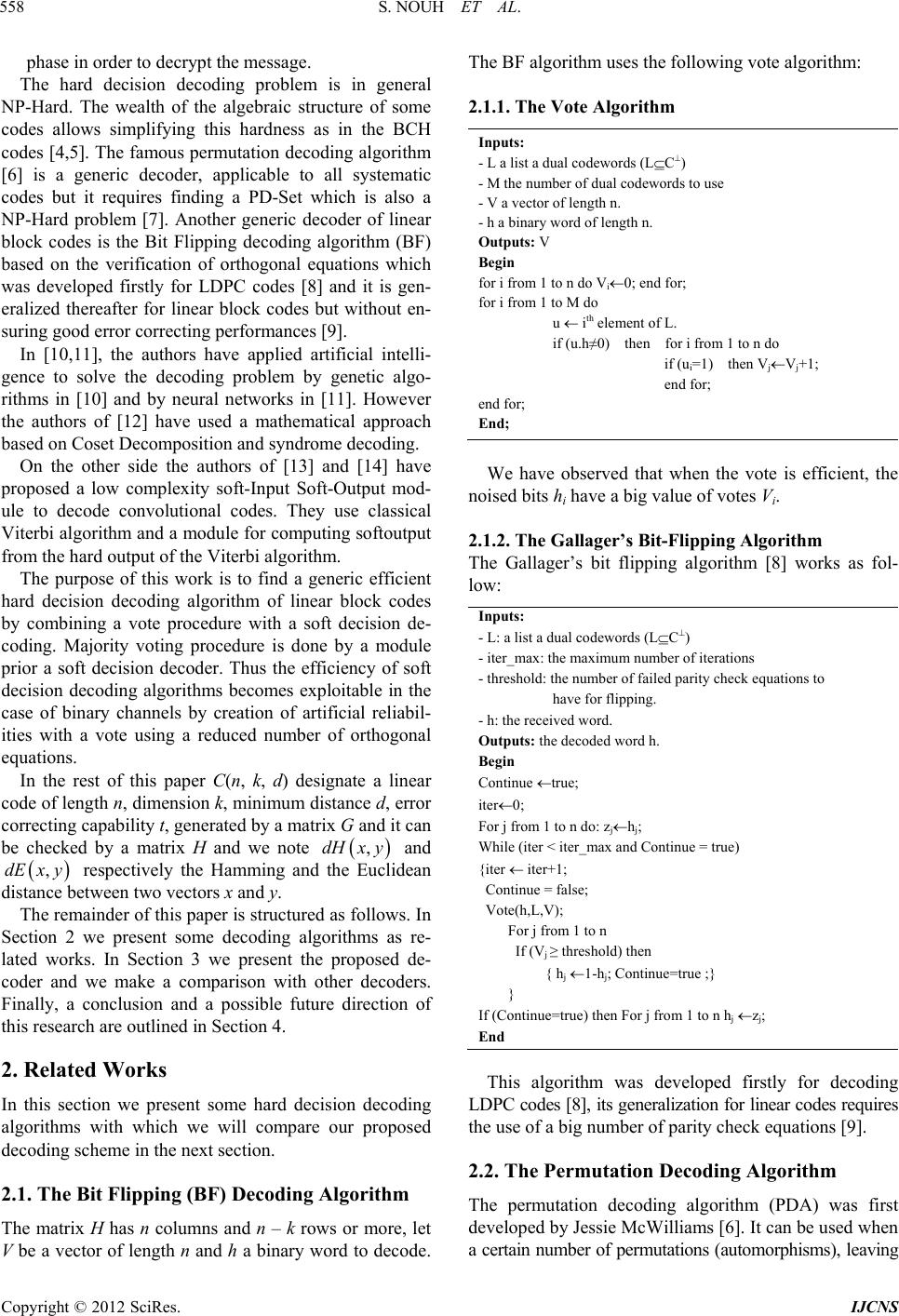 S. NOUH ET AL. 558 phase in order to decrypt the message. The hard decision decoding problem is in general NP-Hard. The wealth of the algebraic structure of some codes allows simplifying this hardness as in the BCH codes [4,5]. The famous permutation decoding algorithm [6] is a generic decoder, applicable to all systematic codes but it requires finding a PD-Set which is also a NP-Hard problem [7]. Another generic decoder of linear block codes is the Bit Flipping decoding algorithm (BF) based on the verification of orthogonal equations which was developed firstly for LDPC codes [8] and it is gen- eralized thereafter for linear block codes but without en- suring good error correcting performances [9]. In [10,11], the authors have applied artificial intelli- gence to solve the decoding problem by genetic algo- rithms in [10] and by neural networks in [11]. However the authors of [12] have used a mathematical approach based on Coset Decomposition and syndrome decoding. On the other side the authors of [13] and [14] have proposed a low complexity soft-Input Soft-Output mod- ule to decode convolutional codes. They use classical Viterbi algorithm and a module for computing softoutput from the hard output of the Viterbi algorithm. The purpose of this work is to find a generic efficient hard decision decoding algorithm of linear block codes by combining a vote procedure with a soft decision de- coding. Majority voting procedure is done by a module prior a soft decision decoder. Thus the efficiency of soft decision decoding algorithms becomes exploitable in the case of binary channels by creation of artificial reliabil- ities with a vote using a reduced number of orthogonal equations. In the rest of this paper C(n, k, d) designate a linear code of length n, dimension k, minimum distance d, error correcting capability t, generated by a matrix G and it can be checked by a matrix H and we note and respectively the Hamming and the Euclidean distance between two vectors x and y. ,dHx y ,dEx y The remainder of this paper is structured as follows. In Section 2 we present some decoding algorithms as re- lated works. In Section 3 we present the proposed de- coder and we make a comparison with other decoders. Finally, a conclusion and a possible future direction of this research are outlined in Section 4. 2. Related Works In this section we present some hard decision decoding algorithms with which we will compare our proposed decoding scheme in the next section. 2.1. The Bit Flipping (BF) Decoding Algorithm The matrix H has n columns and n – k rows or more, let V be a vector of length n and h a binary word to decode. The BF algorithm uses the following vote algorithm: 2 .1.1. The Vote Algorithm Inputs: - L a list a dual codewords (LC) - M the number of dual codewords to use - V a vector of length n. - h a binary word of length n. Outputs: V Begin for i from 1 to n do Vi0; end for; for i from 1 to M do u ith element of L. if (u.h≠0) then for i from 1 to n do if (u i=1) then VjVj+1; end for; end for; End; We have observed that when the vote is efficient, the noised bits hi have a big value of votes Vi. 2.1.2. The Gallager’s Bit-Flipping Algorithm The Gallager’s bit flipping algorithm [8] works as fol- ow: l Inputs: - L: a list a dual codewords (LC) - iter_max: the maximum number of iterations - threshold: the number of failed parity check equations to have for flipping. - h: the received word. Outputs: the decoded word h. Begin Continue true; iter0; For j from 1 to n do: zjhj; While (iter < iter_max and Continue = true) {iter iter+1; Continue = false; Vote(h,L,V); For j from 1 to n If (Vj ≥ threshold) then { h j 1-hj; Continue=true ;} } If (Continue=true) then For j from 1 to n hj zj; End This algorithm was developed firstly for decoding LDPC codes [8], its generalization for linear codes requires the use of a big number of parity check equations [9]. 2.2. The Permutation Decoding Algorithm The permutation decoding algorithm (PDA) was first developed by Jessie McWilliams [6]. It can be used when a certain number of permutations (automorphisms), leaving Copyright © 2012 SciRes. IJCNS 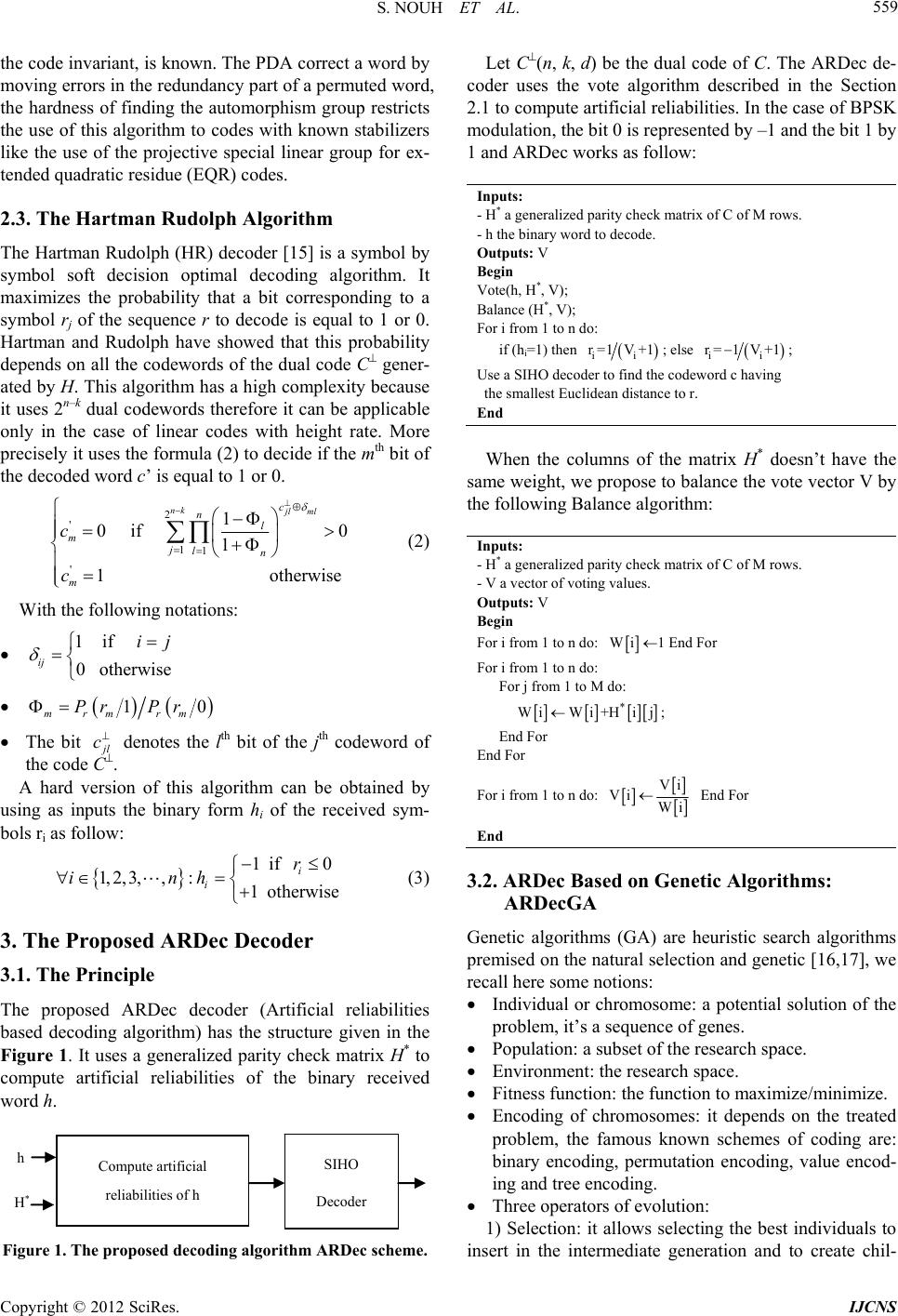 S. NOUH ET AL. 559 the code invariant, is known. The PDA correct a word by moving errors in the redundancy part of a permuted word, the hardness of finding the automorphism group restricts the use of this algorithm to codes with known stabilizers like the use of the projective special linear group for ex- tended quadratic residue (EQR) codes. 2.3. The Hartman Rudolph Algorithm The Hartman Rudolph (HR) decoder [15] is a symbol by symbol soft decision optimal decoding algorithm. It maximizes the probability that a bit corresponding to a symbol rj of the sequence r to decode is equal to 1 or 0. Hartman and Rudolph have showed that this probability depends on all the codewords of the dual code C gener- ated by H. This algorithm has a high complexity because it uses 2n–k dual codewords therefore it can be applicable only in the case of linear codes with height rate. More precisely it uses the formula (2) to decide if the mth bit of the decoded word c’ is equal to 1 or 0. 2 ' 11 ' 1 0if 1 nk n mjl m c c 0 1otherwise jl ml c l n 1 0 otherwie (2) With the following notations: if s ij ij 10 mrm Pr r rm P The bit l c denotes the lth bit of the jth codeword of the code C. A hard version of this algorithm can be obtained by using as inputs the binary form hi of the received sym- bols ri as follow: 1, 2, 3,,:i in 1if 0 1o therwise i r h (3) 3. The Proposed ARDec Decoder 3.1. The Principle The proposed ARDec decoder (Artificial reliabilities based decoding algorithm) has the structure given in the Figure 1. It uses a generalized parity check matrix H* to compute artificial reliabilities of the binary received word h. Compute artificial reliabilities of h SIHO Decoder H * h Figure 1. The proposed decoding algorithm ARDec scheme. Let C(n, k, d) be the dual code of C. The ARDec de- coder uses the vote algorithm described in the Section 2.1 to compute artificial reliabilities. In the case of BPSK modulation, the bit 0 is represented by –1 and the bit 1 by 1 and ARDec works as follow: Inputs: - H* a generalized parity check matrix of C of M rows. - h the binary word to decode. Outputs: V Begin Vote(h, H*, V); Balance (H*, V); For i from 1 to n do: if (h i=1) then ii r=1 V+1 ; else ii r= 1 V+1; Use a SIHO decoder to find the codeword c having the smallest Euclidean distance to r. End When the columns of the matrix H* doesn’t have the same weight, we propose to balance the vote vector V by the following Balance algorithm: Inputs: - H* a generalized parity check matrix of C of M rows. - V a vector of voting values. Outputs: V Begin For i from 1 to n do: Wi * Wi+Hi j 1 End For For i from 1 to n do: For j from 1 to M do: Wi ; End For End For For i from 1 to n do: Vi Vi Wi End For End 3.2. ARDec Based on Genetic Algorithms: ARDecGA Genetic algorithms (GA) are heuristic search algorithms premised on the natural selection and genetic [16,17], we recall here some notions: Individual or chromosome: a potential solution of the problem, it’s a sequence of genes. Population: a subset of the research space. Environment: the research space. Fitness function: the function to maximize/minimize. Encoding of chromosomes: it depends on the treated problem, the famous known schemes of coding are: binary encoding, permutation encoding, value encod- ing and tree encoding. Three operators of evolution: 1) Selection: it allows selecting the best individuals to insert in the intermediate generation and to create chil- Copyright © 2012 SciRes. IJCNS 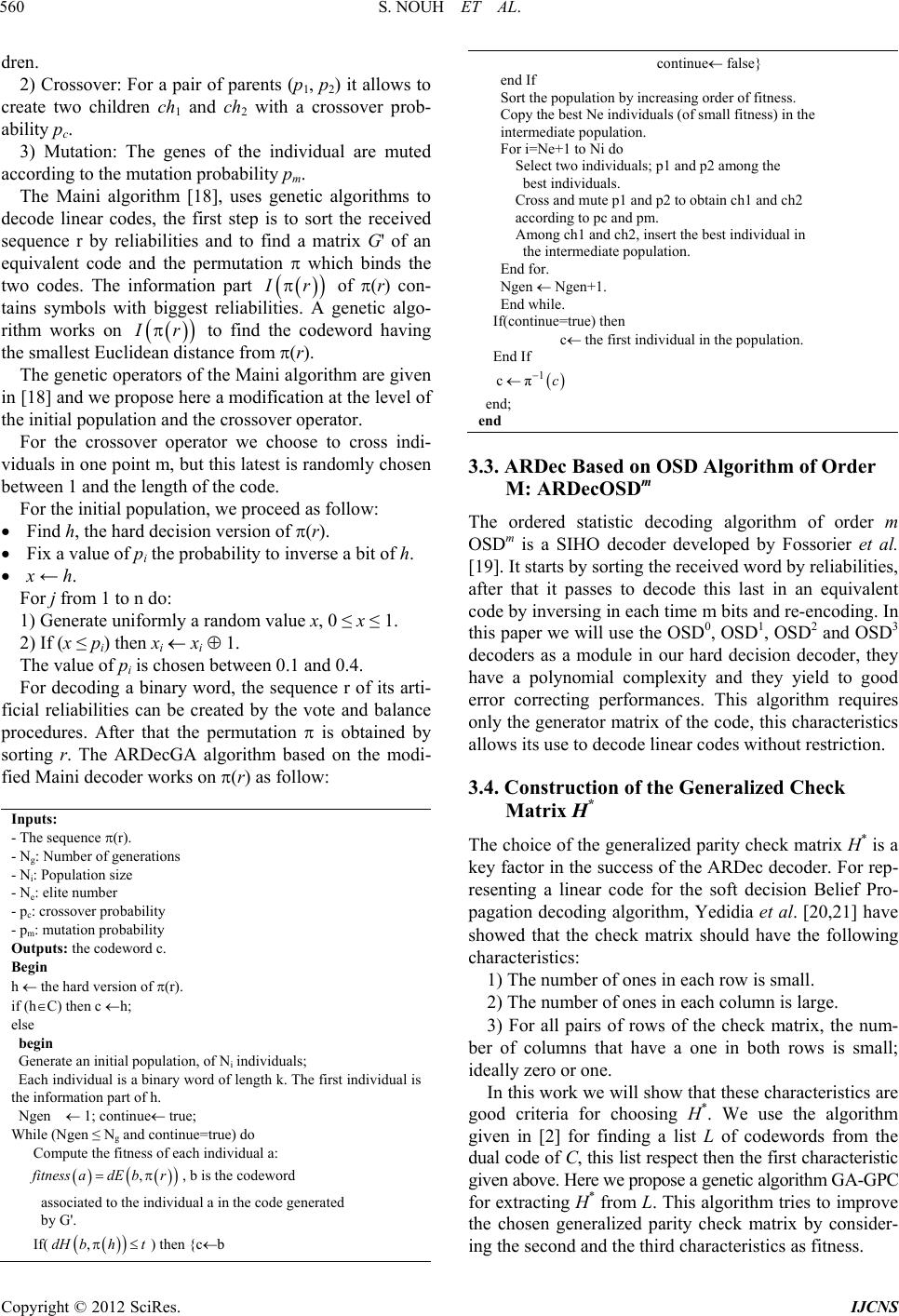 S. NOUH ET AL. 560 dren. 2) Crossover: For a pair of parents (p1, p2) it allows to create two children ch1 and ch2 with a crossover prob- ability pc. 3) Mutation: The genes of the individual are muted according to the mutation probability pm. The Maini algorithm [18], uses genetic algorithms to decode linear codes, the first step is to sort the received sequence r by reliabilities and to find a matrix G' of an equivalent code and the permutation which binds the two codes. The information part r of (r) con- tains symbols with biggest reliabilities. A genetic algo- rithm works on r to find the codeword having the smallest Euclidean distance from (r). The genetic operators of the Maini algorithm are given in [18] and we propose here a modification at the level of the initial population and the crossover operator. For the crossover operator we choose to cross indi- viduals in one point m, but this latest is randomly chosen between 1 and the length of the code. For the initial population, we proceed as follow: Find h, the hard decision version of (r). Fix a value of pi the probability to inverse a bit of h. x ← h. For j from 1 to n do: 1) Generate uniformly a random value x, 0 ≤ x ≤ 1. 2) If (x ≤ pi) then xi xi 1. The value of pi is chosen between 0.1 and 0.4. For decoding a binary word, the sequence r of its arti- ficial reliabilities can be created by the vote and balance procedures. After that the permutation is obtained by sorting r. The ARDecGA algorithm based on the modi- fied Maini decoder works on (r) as follow: Inputs: nce (r). rations hard version of (r). st individual is true) do - The seque - Ng: Number of gene - Ni: Population size - Ne: elite number - pc: crossover probability - pm: mutation probability Outputs: the codeword c. Begin h the if (hC) then c h; else begin Generate an initial population, of Ni individuals; Each individual is a binary word of length k. The fir the information part of h. Ngen 1; continue true; While (Ngen ≤ Ng and continue= Compute the fitness of each individual a: , itness adE br, b is the codeword by G'. associated to the individual a in the code generated ht ) then {cb If( ,dHb continu e false} end If Sort the population by increasing order of fitness. Copy the best Ne individuals (of small fitness) in the intermediate population. For i=Ne+1 to Ni do Select two individuals; p1 and p2 among the best individuals. Cross and mute p1 and p2 to obtain ch1 and ch2 according to pc and pm. Among ch1 and ch2, insert the best individual in the intermediate population. End for. Ngen Ngen+1. End while. If(continue=true) then c the first individual in the population. End If 1 cπc end; end 3.3. ARDec Based on OSD Algorithm of Order M: ARDecOSDm Thm of order m Or et al. [19 iabilities, acode this last in an equivalent c-encoding. In tthe OSD, OSD, OSD2 and OSD3 decooder, they h to good e This algorithm requires oerator matrix of the code, this characteristics ade linear codes without restriction. 3eck rix H Tice of the generalized parity check matrix H* is a key factor in the success of the ARDec decoder. For rep- resenting a linear code for the soft decision Belief Pro- showatrix should have the following sider- . he ordered statistic decoding algorit SDm is a SIHO decoder developed by Fossorie ]. It starts by sorting the received word by rel ero deft that it passes t ode by inversing in each time m bits and re his paper we will use 0 1 ders as a module in our hard decision dec eav a polynomial complexity and they yield rror correcting performances. nly the gen llows its use to deco .4. Construction of the Generalized Ch * Mat he cho pagation decoding algorithm, Yedidia et al. [20,21] have ed that the check m characteristics: 1) The number of ones in each row is small. 2) The number of ones in each column is large. 3) For all pairs of rows of the check matrix, the num- ber of columns that have a one in both rows is small; ideally zero or one. In this work we will show that these characteristics are good criteria for choosing H*. We use the algorithm given in [2] for finding a list L of codewords from the dual code of C, this list respect then the first characteristic given above. Here we propose a genetic algorithm GA-GPC for extracting H* from L. This algorithm tries to improve the chosen generalized parity check matrix by con ing the second and the third characteristics as fitness Copyright © 2012 SciRes. IJCNS 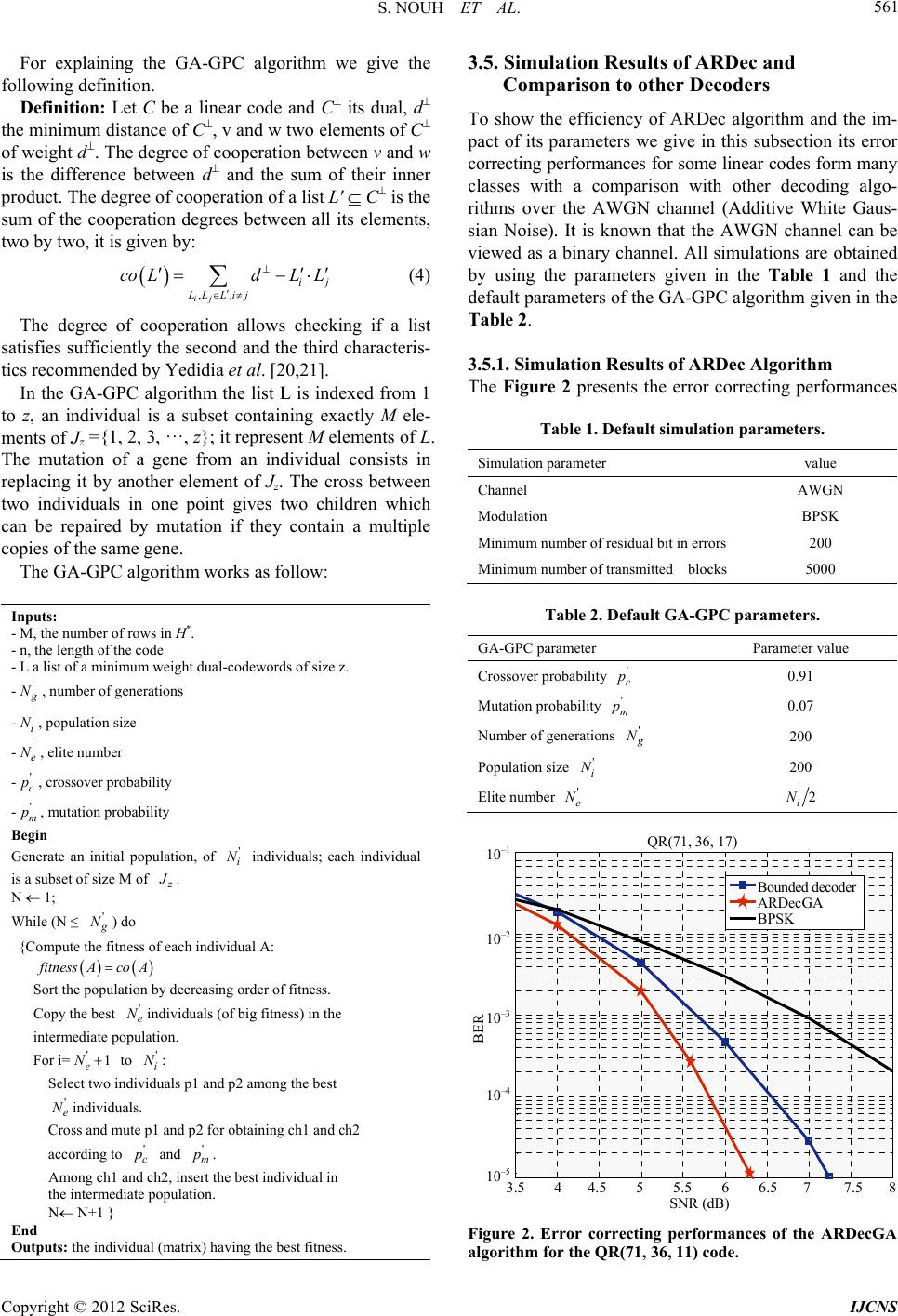 S. NOUH ET AL. 561 3.5. Simulation Results of ARDec and r Decoders Td the im- p give in this subsection its error correcting performances for some linear codes form many clparison with other decoding algo- rithmWGN channel (Additive White Gaus- sn that the AWGN channel can be vwnel. All simulations are obtained bg the parameters given in the Table 1 and the dG T 3latiesults of A R D ec A l gorithm Tting performances ter ue Fohe GA-GPC algorithm we give the elements, tw operation allows checking if a list sa r explaining t following definition. Definition: Let C be a linear code and C its dual, d the minimum distance of C, v and w two elements of C of weight d. The degree of cooperation between v and w is the difference between d and the sum of their inner product. The degree of cooperation of a list L' C is the sum of the cooperation degrees between all its o by two, it is given by: ,, ij ij LLLij co LdLL (4) The degree of co tisfies sufficiently the second and the third characteris- tics recommended by Yedidia et al. [20,21]. In the GA-GPC algorithm the list L is indexed from 1 to z, an individual is a subset containing exactly M ele- ments of Jz ={1, 2, 3, ···, z}; it represent M elements of L. The mutation of a gene from an individual consists in replacing it by another element of Jz. The cross between two individuals in one point gives two children which can be repaired by mutation if they contain a multiple copies of the same gene. The GA-GPC algorithm works as follow: Inputs: - M, the number of rows in H*. - n, the length of the code - L a list of a minimum weight dual-codewords of size z. -' N, number of generations -' i N, population size -' e N, elite number -' c , crossover probability -' m , mutation probability Begin Generate an initial population, of ' i N individuals; each individual is a subset of size M of . N 1; While (N ≤ ' N) do {Compute the fitness of each individual A: itness Aco A Sort the population by decreasing order of fitness. Copy the best ' Nindividu eals (of big fitness) in the intermediate population. ='1 e N to ' i N: Select two individuals p1 and p2 among the best ' e Nindividuals. ross mute p1 and p2 for obtaining ch1 and ch2 ccoto ' c For i C a and rding Comparison to othe o show the efficiency of ARDec algorithm an act of its parameters we asses with a com s over the A iaNoise). It is known ieed as a binary chan y usin efault parameters of the GA-PC algorithm given in the able 2. .5.1. Si muon R he Figure 2 presents the error correc Table 1. Default simulation parameters. Simulation parameval Channel AWGN Modulation BPSK Minimum number of residual bit in errors 200 Minimum number of transmitted blocks 5000 . Parameter value and ' m . Among ch1 and ch2, insert the best individual in the intermediate population. N N+1 } End Outputs: the individual (matrix) having the best fitness. Table 2.efaultA- D GGPC parameters GA-GPC parameter Crossover probability ' c 0.91 Mutation probability m ' 0.07 Number of generations ' N 200 Population size ' i N 200 Elite number ' e N '2 i N 3.5 44.5 55.5 66.5 77.5 8 10 -5 10 -4 10 -3 10 -2 10 -1 SNR (dB) BER QR(71,36,11) Bounded decoder ARDe cGA BPSK 10 –1 10 –2 10 –3 10 –4 10 –5 R 71, 36, 17 Bounded decode ARDecGA BPSK 3.5 4 4.5 5 5.5 6 SNR (dB) BER 6.5 7.5 87 Fnces of thDecGA lgorithm for the QR(71, 36, 11) code. igure 2. Error correcting performae AR a Copyright © 2012 SciRes. IJCNS 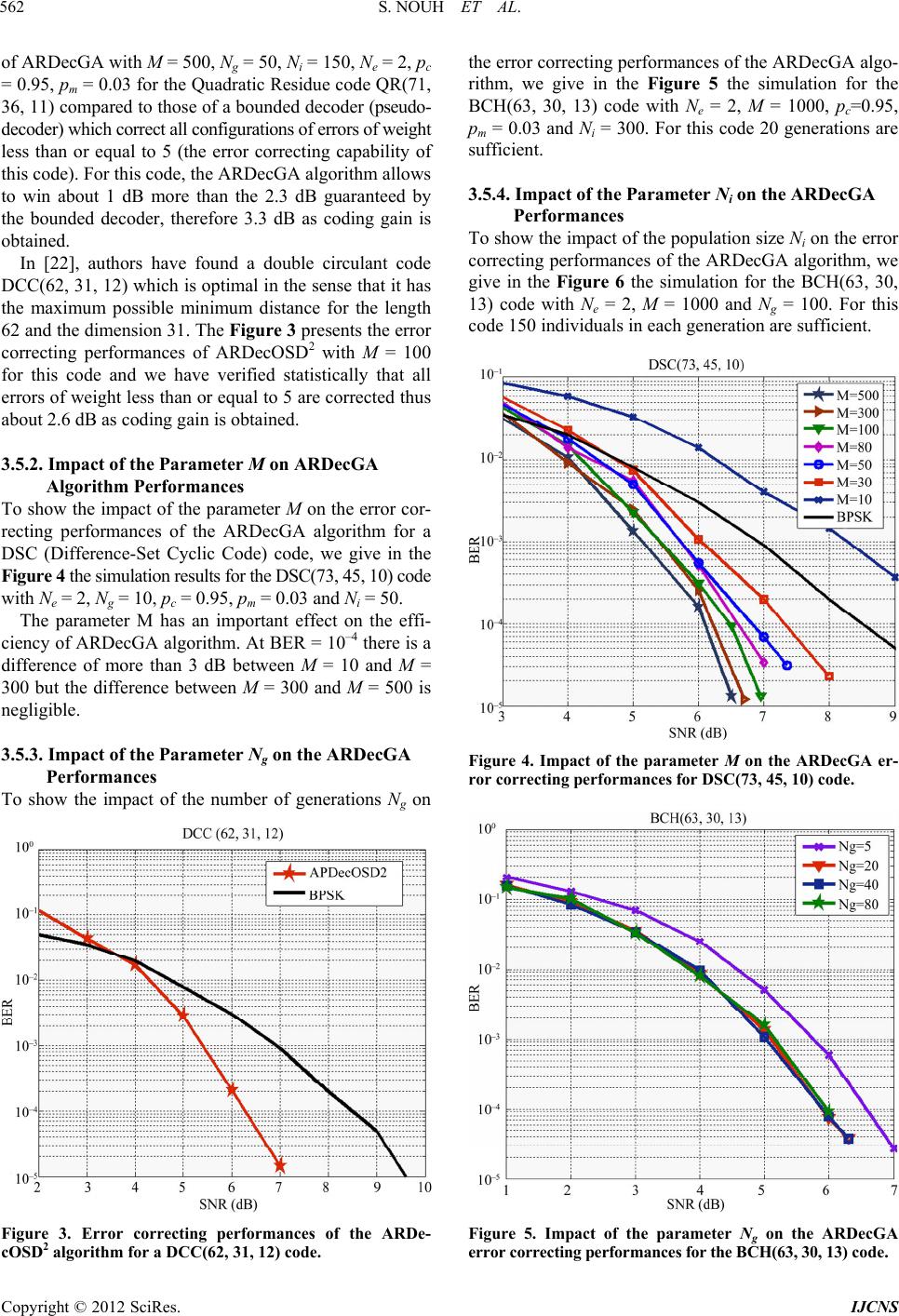 S. NOUH ET AL. 562 of ARDece = 2, pc =for the Quadratic RR(71, 3 to those of a bounde dll configurations of of weight lto (the error correctinability of tdethe ARDecGA alhm allows toore than the 2.3 dB ranteed by tecoder, therefore 3.3 dB as ng gain is o In [22], authors have found a double circulant code , 31, 12) which is optimal in the sense that it has the maximum possible minimum distance for the length 62 and the dimension 31. The Figure 3 presents the error correcting performances of ARDecOSD2 with M = 100 for this code and we have verified statistically that all errors of weight less than or equal to 5 are corrected thus about 2.6 dB as coding gain is obtained. 3.5.2. Impact of the Parameter M on ARDecGA Algor ithm Performa nces To show the impact of the parameter M on the error cor- recting performances of the ARDecGA algorithm for a DSC (Difference-Set Cyclic Code) code, we give in the Figure 4 the simulation results for the DSC(73, 45, 10) code with Ne = 2, Ng = 10, pc = 0.95, pm = 0.03 and Ni = 50. The parameter M has an important effect on the effi- ciency of ARDecGA algorithm. At BER = 10–4 there is GA with M = 500, Ng = 50, Ni = 150, N 0.95, pm = 0.03 6, 11) compared esidue code Q d decoder (pseudo- ecoder) which correct aerrors ess than or equal 5g cap his code). For this co, win about 1 dB m gorit gua he bounded dcodi btained. DCC(62 a difference of more than 3 dB between M = 10 and M = 300 but the difference between M = 300 and M = 500 is negligible. 3.5.3. Impact of the Parameter Ng on the ARDecGA Performances To show the impact of the number of generations Ng on Figure 3. Error correcting performances of the ARDe- 2 the error correcting performances of the ARDecGA algo- cOSD algorithm for a DCC(62, 31, 12) code. rit 3.5.4. Impact of the Parameter Ni on the ARDecGA To shf the population size Ni on the error ive in the Figure 6 the simulation for the BCH(63, 30, 13) code with Ne = 2, M = 1000 and Ng = 100. For this code 150 individuals in each generation are sufficient. hm, we give in the Figure 5 the simulation for the BCH(63, 30, 13) code with Ne = 2, M = 1000, pc=0.95, pm = 0.03 and Ni = 300. For this code 20 generations are sufficient. Performances ow the impact o correcting performances of the ARDecGA algorithm, we g Figure 4. Impact of the parameter M on the ARDecGA er- ror correcting performances for DSC(73, 45, 10) code. Figure 5. Impact of the parameter Ng on the ARDecGA error correcting performances fo r the BCH(63, 30, 13) code. Copyright © 2012 SciRes. IJCNS 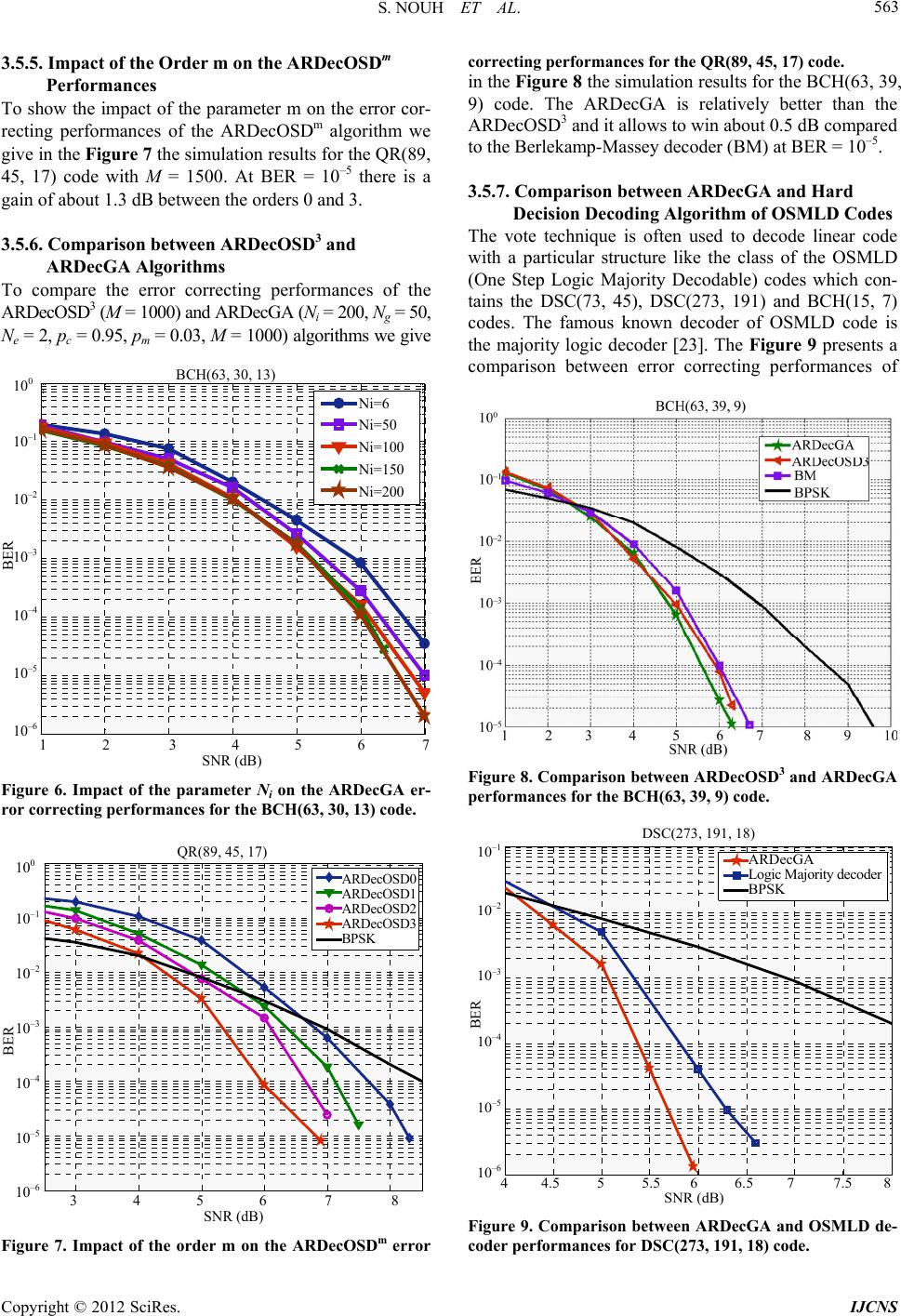 S. NOUH ET AL. 563 3.5.5. Impact of the Order m on the ARDecOSDm Performances To show the impact of the parameter m on the error cor- recting performances of the ARDecOSDm algorithm we give in the Figure 7 the simulation results for the QR(89, 45, 17) code with M = 1500. At BER = 10–5 there is a gain of about 1.3 dB between the orders 0 and 3. 3.5.6. C omparison between ARDecOSD3 and ARDecGA Algorithms To compare the error correcting performances of the ARDecOSD3 (M = 1000) and ARDecGA (Ni = 200, Ng = 50, Ne = 2, pc = 0.95, pm = 0.03, M = 1000) algorithms we give 1234567 10 -6 10 -5 10 -4 10 -3 10 -2 10 -1 10 0 , , Ni=6 Ni=50 Ni=100 Ni=150 Ni=200 BCH 63, 30, 13 10 0 –1 10 –2 10 –3 10 –4 10 –5 10 –6 10 BER i=6 i=50 i=100 i=150 i=200 1 2 3 4 5 6 7 SNR dB Figure 6. Impact of the parameter Ni on the ARDecGA er- ror correcting performances for the BCH(63, 30, 13) code. 3 4 5 6 7 8 10-6 10-5 10-4 10-3 10-2 10-1 100 SNR (dB) BER QR(89,45,17) ARDecOSD0 ARDecOSD1 ARDecOSD2 ARDecOSD3 BPSK QR(89, 45, 17) 10 0 –2 10 –6 10 –1 10 10 –3 10 –4 10 –5 ARDecOSD0 ARDecOSD1 ARDecOSD2 ARDecOSD3 BPSK 3 4 5 6 7 8 SNR (dB) BER Figure 7. Impact of the order m on the ARDecOSDm error correcting performances for the QR(89, 45, 17) code. in the Figure 8 the simulation results for the BCH(63, 39, 9) code. The ARDecGA is relatively better than the ARDecOSD3 and it allows to win about 0.5 dB compared to the Berlekamp-Massey decoder (BM) at BER = 10–5. 3.5.7. C omparison between ARDecGA and Hard Decision Decoding Algorithm of OSMLD Codes The vote technique is often used to decode linear code with a particular structure like the class of the OSMLD (One Step Logic Majority Decodable) codes which con- tains the DSC(73, 45), DSC(273, 191) and BCH(15, 7) codes. The famous known decoder of OSMLD code is the majority logic decoder [23]. The Figure 9 presents a comparison between error correcting performances of Figure 8. Comparison between ARDecOSD3 and ARDecGA performances for the BCH(63, 39, 9) code. 44.5 55.5 66.5 77.5 8 10 -6 10 -5 10 -4 10 -3 10 -2 10 -1 DSC(273,191,18) SNR dB ARDecGA Logic Majority decoder BPSK DSC(273, 191, 18) 10 –1 10 –2 –5 ARDecGA Logic Majority decoder BPSK 10 –3 10 –4 10 10 –6 BER 4 4.5 5 5.5 6 6.5 7 7.5 8 SNR dB Figure 9. Comparison between ARDecGA and OSMLD de- coder performances for DSC(273, 191, 18) code. Copyright © 2012 SciRes. IJCNS 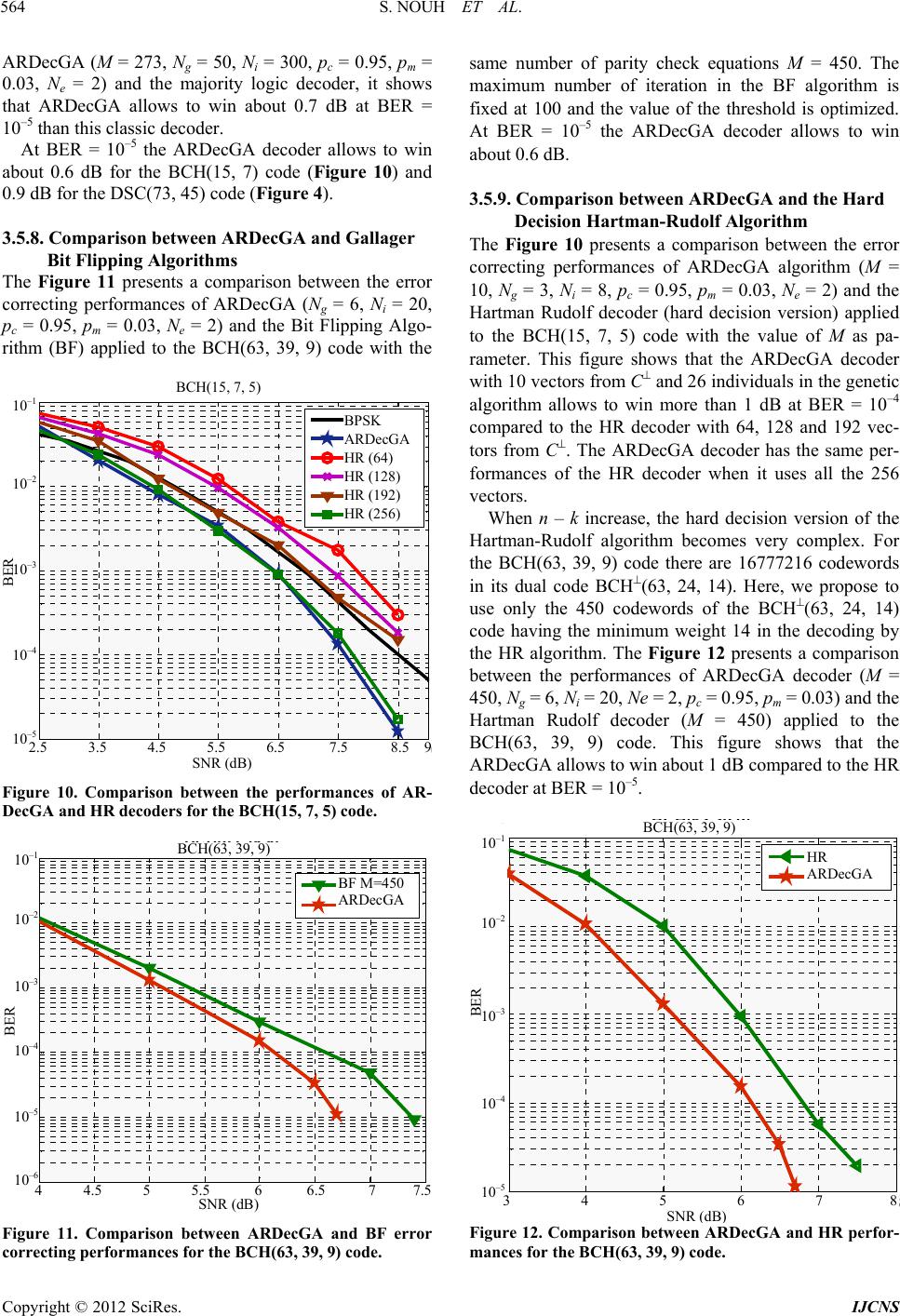 S. NOUH ET AL. 564 ARDecGA (M = 273, Ng = 50, Ni = 300, pc = 0.95, pm = 0.03, Ne = 2) and the majority logic decoder, it shows that ARDecGA allows to win about 0.7 dB at BER = 10–5 than this classic decoder. At BER = 10–5 the ARDecGA decoder allows to win about 0.6 dB for the BCH(15, 7) code (Figure 10) and 0.9 dB for the DSC(73, 45) code (Figure 4). 3.5.8. C omparison be t w e en ARDecGA and G allager Bit Flipping Algorithms The Figure 11 presents a comparison between the error correcting performances of ARDecGA (Ng = 6, Ni = 20, pc = 0.95, pm = 0.03, Ne = 2) and the Bit Flipping Algo- rithm (BF) applied to the BCH(63, 39, 9) code with the 2.5 3.54.55.5 6.5 7.5 8.5 10 -5 10 -4 10 -3 10 -2 10 -1 BCH(15,7,5) BPSK ARDecGA HR (64) HR (128) HR (192) HR (256) 10 –1 10 –2 10 –3 10 –4 10 –5 BCH(15, 7, 5) 2.5 3.5 4.5 5.5 6.5 7.5 8.5 9 SNR dB BPSK ARDecGA HR (64) HR (128) HR (192) HR (256) BER Figure 10. Comparison between the performances of AR- DecGA and HR decoders for the BCH(15, 7, 5) code. 44.5 55.5 66.5 77. 10 -6 10 -5 10 -4 10 -3 10 -2 10 -1 , , BF M=450 ARDecGA 10–1 10–2 10–3 10–4 10–5 10–6 BCH 63 39 9 BF M=450 ARD ecG A 4 4.5 5 5.5 6 6.5 7 7. SNR 5 dB xed at 100 and the value of the threshold is optimized. At BER = 10–5 the ARDecGA decoder allows to win about 0.6 dB. 3.5.9. C omparison between ARDecGA and the Hard Decision Hartman-Rudolf Algorithm The Figure 10 presents a comparison between the error correcting performances of ARDecGA algorithm (M = 10, Ng = 3, Ni = 8, pc = 0.95, pm = 0.03, Ne = 2) and the Hartman Rudolf decoder (hard decision version) applied to the BCH(15, 7, 5) code with the value of M as pa- rameter. This figure shows that the ARDecGA decoder with 10 vectors from C and 26 individuals in the genetic algorithm allows to win more than 1 dB at BER = 10–4 compared to the HR decoder with 64, 128 and 192 vec- tors from C. The ARDecGA decoder has the same per- formances of the HR decoder when it uses all the 256 vectors. e BCH(63, 39, 9) code there are 16777216 codewords in its dual code BCH(63, 24, 14). Here, we propose to use only the 450 codewords of the BCH(63, 24, 14) code having the minimum weight 14 in the decoding by the HR algorithm. The Figure 12 presents a comparison between the performances of ARDecGA decoder (M = 450, Ng = 6, Ni = 20, Ne = 2, pc = 0.95, pm = 0.03) and the Hartman Rudolf decoder (M = 450) applied to the BCH(63, 39, 9) code. This figure shows that the ARDecGA allows to win about 1 dB compared to the HR decoder at BER = 10–5. BER Figure 11. Comparison between ARDecGA and BF error correcting performances for the BCH(63, 39, 9) code. same number of parity check equations M = 450. The maximum number of iteration in the BF algorithm is fi When n – k increase, the hard decision version of the Hartman-Rudolf algorithm becomes very complex. For th , , 34567 10 -5 10 -4 10 -3 10 -2 10 -1 HR ARDecGA BCH(63, 39, 9) 10 –1 10 –2 HR ARDecGA 10 –3 10 –4 10 –5 3 4 5 6 7 8 SNR dB BE Figure 12. Comparison between ARDecGA and HR perfor- mances for the BCH(63, 39, 9) code. Copyright © 2012 SciRes. IJCNS 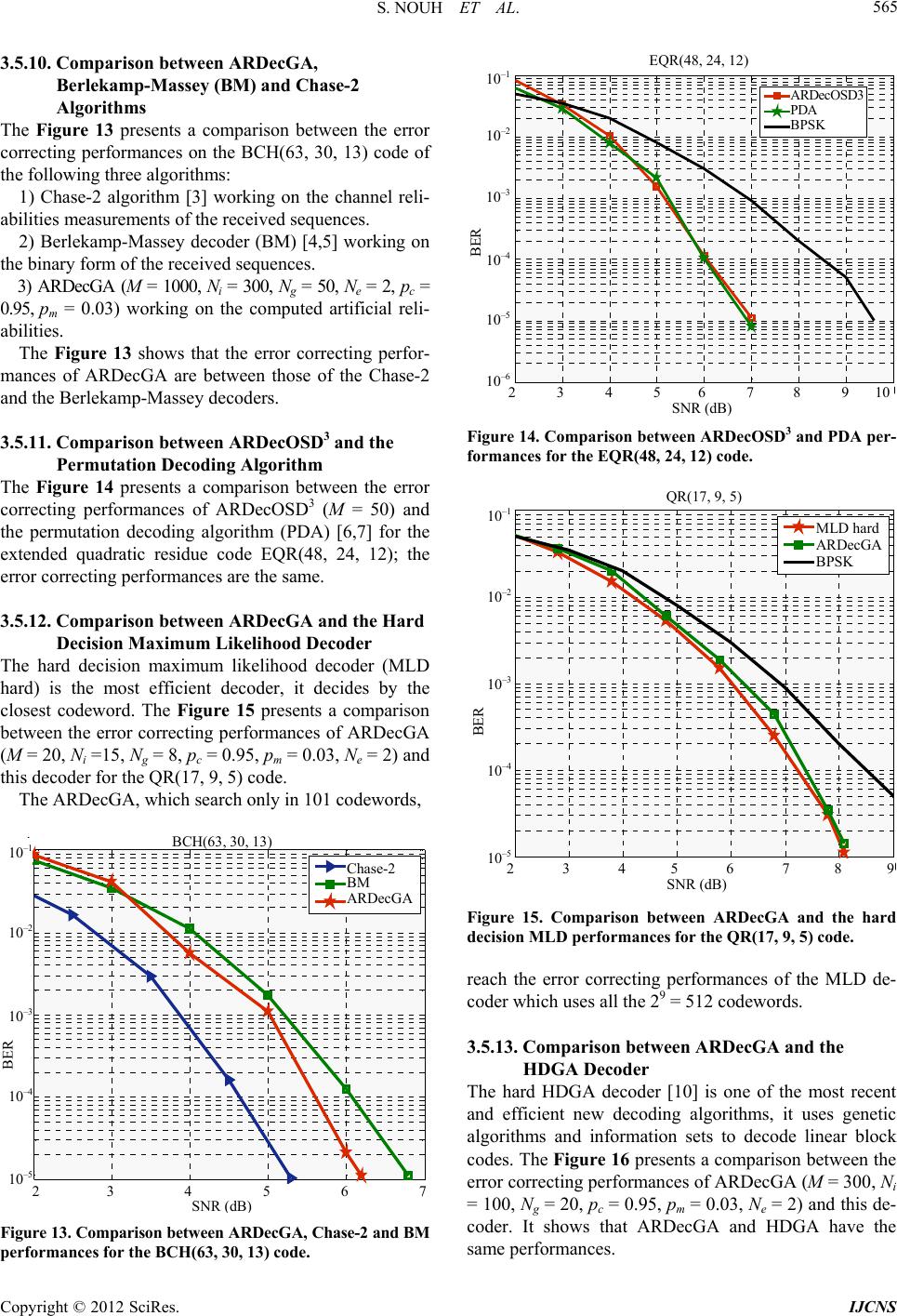 S. NOUH ET AL. 565 3.5.10. Comparison between ARDecGA, Berlekamp-Massey (BM) and Chase-2 Algorithms The Figure 13 presents a comparison between the error correcting performances on the BCH(63, 30, 13) code of the following three algorithms: 1) Chase-2 algorithm [3] working on the channel reli- abilities measurements of the received sequences. 2) Berlekamp-Massey decoder (BM) [4,5] working on th ee code EQR(48, 24, 12); the error correcting performances are the same. 3.5.12. Comparison between ARDecGA and the Hard Decision Maximum Likelihood Decoder The hard decision maximum likelihood decoder (MLD hard) is the most efficient decoder, it decides by the closest codeword. The Figure 15 presents a comparison between the error correcting performances of ARDecGA (M = 20, Ni =15, Ng = 8, pc = 0.95, pm = 0.03, Ne = 2) and this decoder for the QR(17, 9, 5) code. The ARDecGA, which search only in 101 codewords, e binary form of the received sequences. 3) ARDecGA (M = 1000, Ni = 300, Ng = 50, Ne = 2, pc = 0.95, pm = 0.03) working on the computed artificial reli- abilities. The Figure 13 shows that the error correcting perfor- mances of ARDecGA are between those of the Chase-2 and the Berlekamp-Massey decoders. 3.5.11. Comparison between ARDecOSD3 and the Permutation Decoding Algorithm The Figure 14 presents a comparison between the error correcting performances of ARDecOSD3 (M = 50) and the permutation decoding algorithm (PDA) [6,7] for the xtended quadratic r sidue 23 4 5 6 10 -5 10 -4 10 -3 10 -2 10 -1 SNR dB , , Chase-2 BM ARDecGA 10 –1 10 –2 –4 1 10 –3 10 0 –5 BER BCH 63 30 13 2 3 4 5 6 7 NR dB Chase-2 BM ARD ecG A Figure 13. Comparison between ARDecGA, Chase-2 and BM performances for the BCH(63, 30, 13) code. 2 34 567 891 10 -6 10 -5 10 -4 10 -3 10 -2 10 -1 SNR dB BER EQR(48,24,12) ARDecOSD3 PDA BPSK 10 –1 10 –2 10 –3 –6 10 –4 10 –5 10 EQR(48, 24, 12) ARDecOS 3 PDA BPS BER 2 3 4 5 6 7 8 9 10 SNR dB Figure 14. Comparison between ARDecOSD3 and PDA per- formances for the EQR(48, 24, 12) code. 2 3 45 67 8 10 -5 10 -4 10 -3 10 -2 10 -1 RQ(17,9,5) SNR dB MLD hard ARDecGA BPSK 10 –1 10 10 –3 10 –4 10 –5 –2 QR(17, 9, 5) MLD hard ARD ecG A BPSK BER 2 3 4 5 6 7 8 9 SNR (dB) Figure 15. Comparison between ARDecGA and the hard decision MLD performances for the QR(17, 9, 5) code. reach the error correcting performances of the MLD de 3.5.13. Comparison between ARDecGA and the HDGA Decoder The hard HDGA decoder [10] is one of the most recent and efficient new decoding algorithms, it uses genetic algorithms and information sets to decode linear block codes. The Figure 16 presents a comparison between the error correcting performances of ARDecGA (M = 300, Ni = 100, Ng = 20, pc = 0.95, pm = 0.03, Ne = 2) and this de- coder. It shows that ARDecGA and HDGA have the same performances. - coder which uses all the 29 = 512 codewords. Copyright © 2012 SciRes. IJCNS  S. NOUH ET AL. 566 3.6. Complexity of ARDec The complexity of ARDec is variable and it depends on the following parameters: The parameter M. The code length n. The code dimension k. The weight of the error to decode. The complexity of the auxiliary SIHO decoder. The Table 3 presents an upper bound of the complex- ity of ARDecGA and ARDecOSDm and it gives those of BM and HDGA algorithms. This table shows that the complexity of ARDecGA is polynomial in n however the one of ARDecOSDm is polynomial in nm. Both the com- plexity of HDGA and the one of the BM algorithms are polynomial in n2. The Figure 17 shows a basic property of error cor- ne codeword c in e sphere of radius t (error correcting capability t of the code) centered on h. recting code in the ambient space. If h is a binary re- ceived word then there exists at most o th 1234567 10-5 10-4 10-3 10-2 10-1 100 SNR dB , , HDGA ARDecGA 100 10–1 10–2 10–3 10–4 10–5 BCH(63, 45, 7) 1 2 3 4 5 SNR 6 7 dB HDGA ARD ecG A BER Figure 16. Comparison between ARDecGA and the hard decision HDGA performances for the BCH(63, 45, 7) code. Co Table 3. Complexity of BM, HDGA and ARDec algorithms. Decoder mplexity ARDecOSDm Less than or equal to OMn 1m n ARDecGA Less than or equal to log ign i OMn NNkN ARDec based on SIHO decoder Less than or equal to SIHO decoderOMn O Berlekamp-Massey O(n2) HDGA 2log ignn i ON N kkN c 1 c 2 c 3 c 4 c 5 c 6 h c t Figure 17. Basic property of error correcting codes. In the decoding steps of h, the algorithm stops when e codeword c at Hamming distance less than or equal to t is found. This stop criterion allows reducing consid- erably the complexity of ARDec. The Figure 18 shows the average number of generations required to decode errors of weight between 0 and 9 for the BCH(63, 30, 13) code of error correcting capability t = 6 by the ARDec- GA algorithm. It shows that the errors of weight less than or equal to t – 1 are decoded in the first generation; the errors of weight t requires about 2.86 generations at av- erage and the errors of weight greater than t requires the use of 100 generations because generally the stop crite- rion isn’t verified in this case. The Figure 18 shows that the use of only three gen- erations allows to correct errors of weight less than or equal to t (correctable errors) and justifies that ARDecGA has in practice a small complexity comparing to the up- per bound given in the Table 3. When the number of generations N and the population about 90% of err 7 and 46% of er- rors of weight 8 for the B of error apability equa usion and Perspectives In this paper we have preshard decision ses the dual spce of code C to compute artificial reliabilities of binary the by a my voting procedure. The ls with lowest reliabilities are moved in thre- dundancy part of the word (h) by using a permutation th g size Ni are sufficient the ARDecGA algorithm allows orrecting some errors of weight more than t. The Figure c 19 shows that the use of ARDecGA with M = 1000, Ng = 100, pc = 0.95, pm = 0.03 and Ni = 300 allows the correc- tion of ors of weight CH(63, 30, 13) code l to 6. correcting c 4. Concl ented an efficient uadecoding algorithm whicha linear received word hajorit symboe Copyright © 2012 SciRes. IJCNS 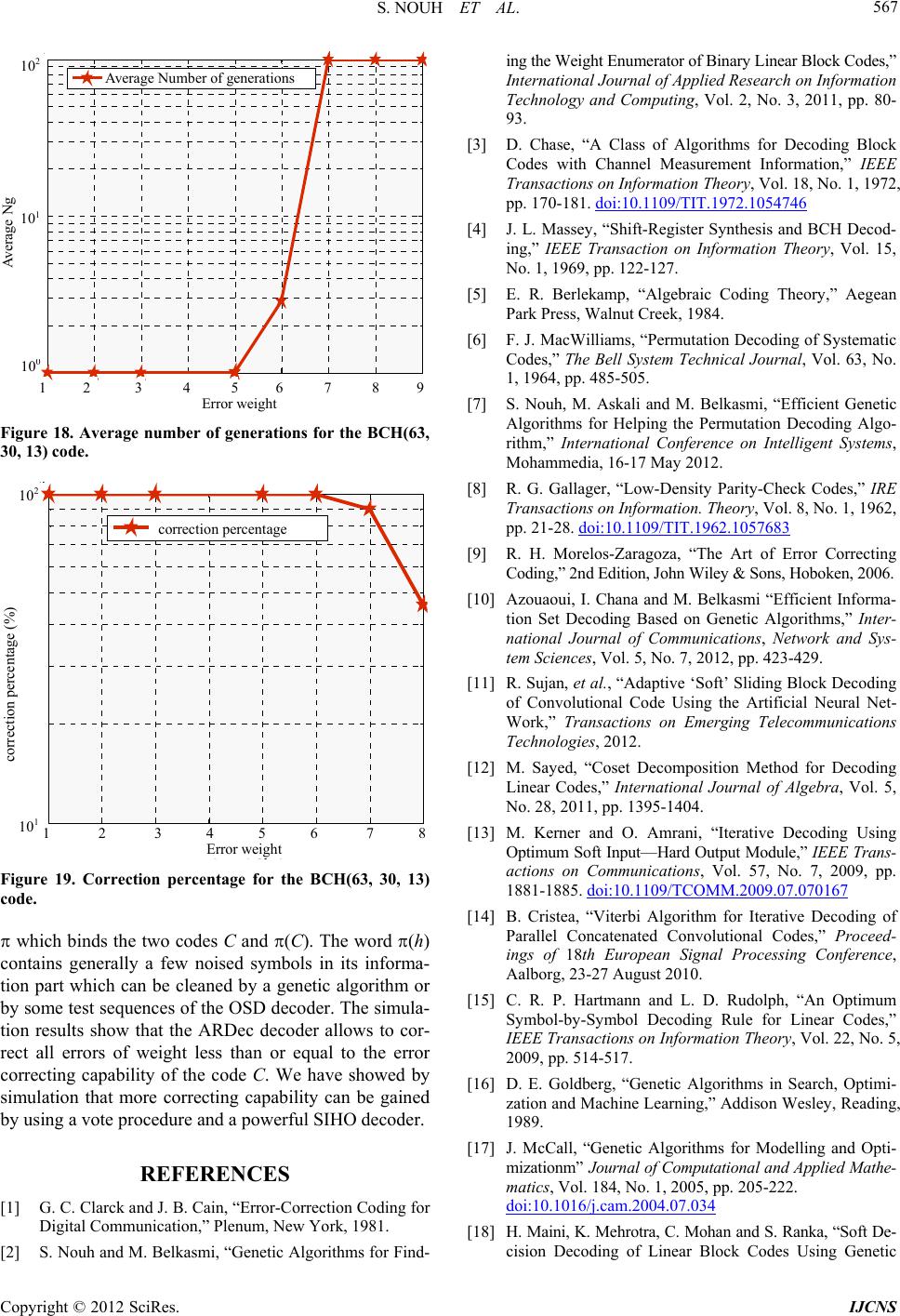 S. NOUH ET AL. 567 1234 56789 10 0 10 1 10 Error weight Average Ng Average Number of generations Average Number of generations Average Ng 10 2 10 1 10 1 2 3 4 5 6 7 Error weight 8 9 Figure 18. Average number of generations for the BCH(63 30, , 13) code. 12 3 4 5 6 7 8 10 1 10 correc on percen age correct ion percentage correction percentage correction percentage (%) 1 2 3 4 5 6 7 8 Error weight 10 1 Figure 19. Correction percentage 10 2 for the BCH(63, 30, 13) co C. We have showed by ty can be gained SIHO decoder. ing the Weight Enumerator of Binary Linear Block Codes,” International Journal of Applied Research on Information Technology and Computing, Vol. 2, No. 3, 2011, pp. 80- 93. [3] D. Chase, “A Class of Algorithms for Decoding Block Codes with Channel Measurement Information,” IEEE Transactions on Information Theory, Vol. 18, No. 1, 1972, pp. 170-181. doi:10.1109/TIT.1972.1054746 [4] J. L. Massey, “Shift-Register Synthesis and BCH Decod- ing,” IEEE Transaction on Information Theory, Vol. 15, No. 1, 1969, pp. 122-127. [5] E. R. Berlekamp, “Algebraic Coding Theory,” Aegean Park Press, Walnut Creek, 1984. [6] F. J. MacWilliams, “Permutation Decoding of Systematic Codes,” The Bell System Technical Journal, Vol. 63, No. 1, 1964, pp. 485-505. [7] S. Nouh, M. Askali and M. Belkasmi, “Efficient Genetic edia, 16-17 May 2012. [8] R. G. Gallager, “Low-Density Parity-Check Codes,” IRE Transactions on Information. Theory, Vol. 8, No. 1, 1962, pp. 21-28. doi:10.1109/TIT.1962.1057683 de. which binds the two codes C and (C). The word (h) contains generally a few noised symbols in its informa- tion part which can be cleaned by a genetic algorithm or by some test sequences of the OSD decoder. The simula- tion results show that the ARDec decoder allows to cor- rect all errors of weight less than or equal to the error correcting capability of the code simulation that more correcting capabili by using a vote procedure and a powerful REFERENCES [1] G. C. Clarck and J. B. Cain, “Error-Correction Coding for Digital Communication,” Plenum, New York, 1981. [2] S. Nouh and M. Belkasmi, “Genetic Algorithms for Find- Algorithms for Helping the Permutation Decoding Algo- rithm,” International Conference on Intelligent Systems, Mohamm [9] R. H. Morelos-Zaragoza, “The Art of Error Correcting Coding,” 2nd Edition, John Wiley & Sons, Hoboken, 2006. [10] Azouaoui, I. Chana and M. Belkasmi “Efficient Informa- tion Set Decoding Based on Genetic Algorithms,” Inter- national Journal of Communications, Network and Sys- tem Sciences, Vol. 5, No. 7, 2012, pp. 423-429. [11] R. Sujan, et al., “Adaptive ‘Soft’ Sliding Block Decoding of Convolutional Code Using the Artificial Neural Net- Work,” Transactions on Emerging Telecommunications Technologies, 2012. [12] M. Sayed, “Coset Decomposition Method for Decoding Linear Codes,” International Journal of Algebra, Vol. 5, No. 28, 2011, pp. 1395-1404. [13] M. Kerner and O. Amrani, “Iterative Decoding Using Optimum Soft Input—Hard Output Module,” IEEE Tran s- actions on Communications, Vol. 57, No. 7, 2009, pp. 1881-1885. doi:10.1109/TCOMM.2009.07.070167 [14] B. Cristea, “Viterbi Algorithm for Iterative Decoding of [17] J. McCall, “Genetic Algorithms for Modelling and Opti- mizationm” Jond Applied Mathe- matics, Vol. 1222. Parallel Concatenated Convolutional Codes,” Proceed- ings of 18th European Signal Processing Conference, Aalborg, 23-27 August 2010. [15] C. R. P. Hartmann and L. D. Rudolph, “An Optimum Symbol-by-Symbol Decoding Rule for Linear Codes,” IEEE Transactions on Information Theory, Vol. 22, No. 5, 2009, pp. 514-517. [16] D. E. Goldberg, “Genetic Algorithms in Search, Optimi- zation and Machine Learning,” Addison Wesley, Reading, 1989. urnal of Computational a 84, No. 1, 2005, pp. 205- doi:10.1016/j.cam.2004.07.034 [18] H. Maini, K. Mehrotra, C. Mohan and S. Ranka, “Soft De- cision Decoding of Linear Block Codes Using Genetic Copyright © 2012 SciRes. IJCNS 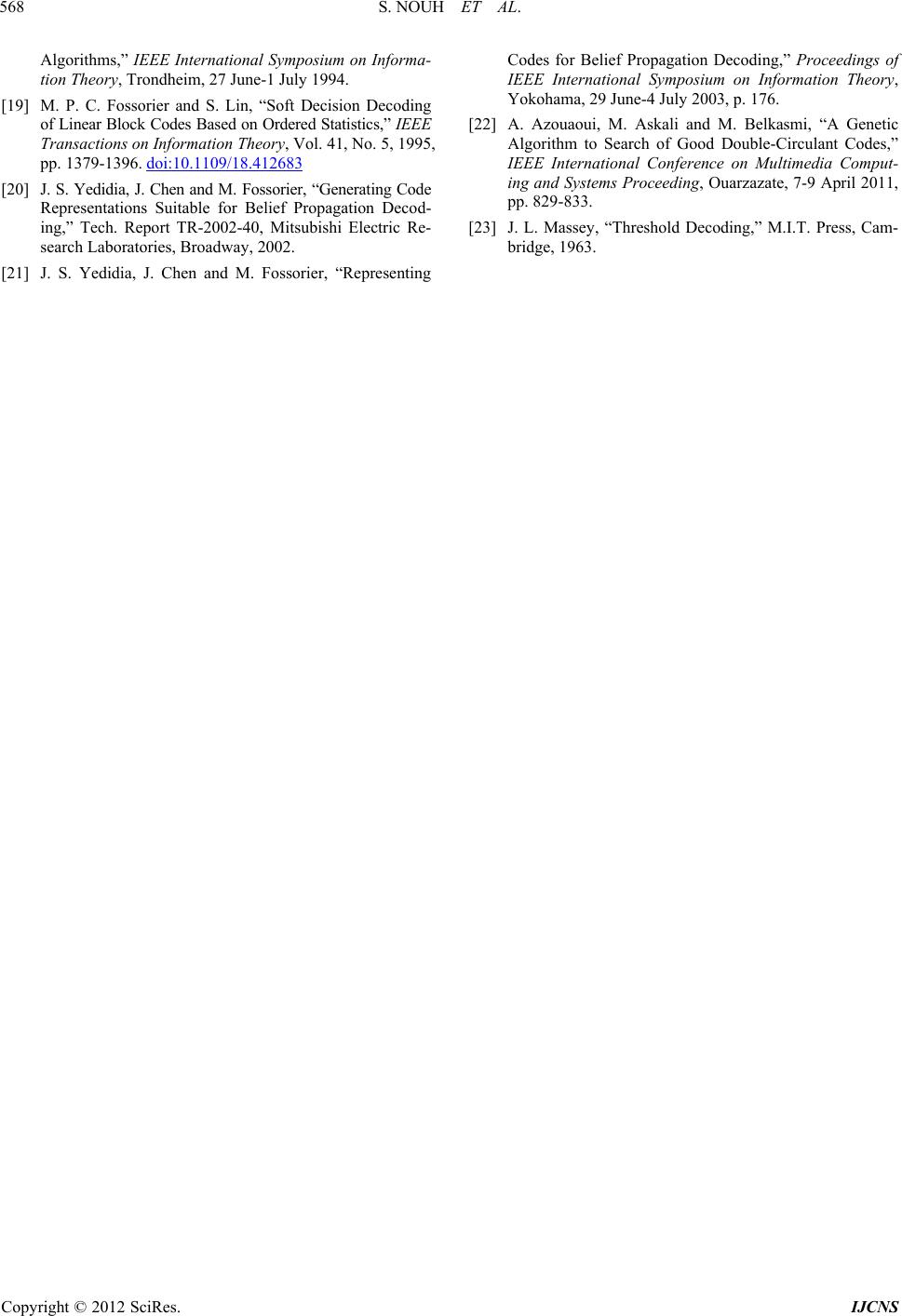 S. NOUH ET AL. Copyright © 2012 SciRes. IJCNS 568 near Block Codes Based on Ordered Statistics,” IEEE Algorithms,” IEEE International Symposium on Informa- tion Theory, Trondheim, 27 June-1 July 1994. [19] M. P. C. Fossorier and S. Lin, “Soft Decision Decoding of Li Transactions on Information Theory, Vol. 41, No. 5, 1995, pp. 1379-1396. doi:10.1109/18.412683 [20] J. S. Yedidia, J. Chen and M. Fossorier, “Generating Code Representations Suitable for Belief Propagation Decod- d M. Fossorier, “Representing Algo ing,” Tech. Report TR-2002-40, Mitsubishi Electric Re- search Laboratories, Broadway, 2002. [21] J. S. Yedidia, J. Chen an Codes for Belief Propagation Decoding,” Proceedings of IEEE International Symposium on Information Theory, Yokohama, 29 June-4 July 2003, p. 176. [22] A. Azouaoui, M. Askali and M. Belkasmi, “A Genetic rithm to Search of Good Double-Circulant Codes,” IEEE International Conference on Multimedia Comput- ing and Systems Proceeding, Ouarzazate, 7-9 April 2011, pp. 829-833. [23] J. L. Massey, “Threshold Decoding,” M.I.T. Press, Cam- bridge, 1963.
|